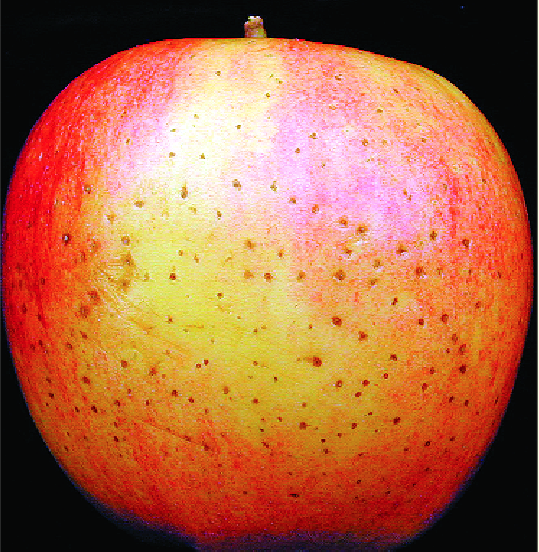
Lenticel breakdown appears after packing in the form of darkened lenticels or small brown spots on the skin of the fruit.
(Photos courtesy of Eugene Kupferman)
—Orchard to orchard susceptibility: Unknown.
—Maturity: Unknown, but research is scheduled for the 2005 crop.
—Dye test: The aniline blue dye test appears to correlate well with the incidence of lenticel breakdown that subsequently develops (see Web site for instructions).
—Prestorage treatment: Evidence from research with the 2004 crop indicated that susceptible lots of Gala apples treated with SmartFresh, then stored in controlled-atmosphere (CA) storage, developed more lenticel breakdown after packing than fruit not treated with SmartFresh. Treated fruit stored less than four months in air developed the same amount of lenticel breakdown as fruit that was not treated. Tests will be conducted in 2005 to determine whether fruit treated with SmartFresh, then stored in air, compare with treated fruit stored in CA.
—Length of time in storage: Research with the 2004 crop showed that the longer the fruit are in storage the more susceptible they are to develop lenticel breakdown after packing.
—Presizing versus commit to pack: Research with the 2004 crop of Gala and Fuji apples showed that presized fruit is more susceptible to develop lenticel breakdown than fruit that is packed directly. In Gala apples, the interval between the time fruit is presized and packed influences lenticel breakdown incidence. Gala apples packed immediately after presizing had less lenticel breakdown than fruit presized then stored one to three weeks prior to packing. Fuji apples had the same amount of lenticel breakdown after packing regardless of time delay between presize and packing. We have scheduled a test of bin filling machinery and its effect on lenticel breakdown for 2005.
—Dump tank chemicals: Packing line chemicals strongly affect the incidence of lenticel breakdown. Dump tank chemical additives caused significantly more damage when applied at higher than label rates. Delay in packing of five to seven days after dump tank (presize) treatments increased the incidence and severity of the damage in Gala apples for all treatments, versus fruit packed immediately after the treatments.
—Dump tank water and fruit temperature: Cold apples rinsed in cold water had less lenticel breakdown damage than apples warmed in water and waxed.
—Hyperclean: Fruit treated with the Hyperclean system did not develop more lenticel breakdown when packed on a commit-to-pack line.
—Soaps or detergents: Applied as line sprays, these greatly increased the incidence of lenticel breakdown when used at higher than label rates. It was not possible to test all cleaners on the market, but in a test using a single alkaline cleaner, a neutral pH cleaner, and an acidic cleaner, the alkaline cleaner did not cause lenticel breakdown damage significantly different from water. The acid and neutral cleaner applied at label rate caused a significant increase in the incidence and severity of lenticel breakdown.
—Wax: The type of wax (carnauba or shellac) did not affect the incidence or severity of lenticel breakdown damage.
—Liquid bleach (sodium hypochlorite): Bleach in solution to provide chlorine did not increase lenticel breakdown over a wide range of concentrations, conductivities, or temperatures. Gala apples treated with a fungicide applied in a carnauba wax line spray did not develop more lenticel breakdown damage than fruit treated with wax alone. The following are my thoughts based on the very limited research done thus far on how to handle fruit to minimize losses from lenticel breakdown.
Although it is not yet known why fruit from certain orchards are more susceptible than fruit from other orchards, packing house management could either test all orchards at harvest using the dye test, which appears to indicate fruit susceptibility, or assume all blocks of Gala are susceptible. Susceptible fruit should be packed early in the season (stored for four months or less) and marketed.
This fruit can be treated with SmartFresh, stored in air, and presized. The interval between presizing and packing should be less than seven days. Fruit that must be stored longer should be packed on a commit-to-pack line. All fruit should be treated with a minimum of packing line soaps or detergent chemicals used at the lowest concentration possible. When a presize is used, the fruit should be packed as soon as possible.
Funding from the Washington Tree Fruit Research Commission and AgroFresh is acknowledged as well as the help of Michael Young at Stemilt Growers. Updating of the research packing line was provided by Van Doren Sales and Stemilt Growers, Inc.




Leave A Comment